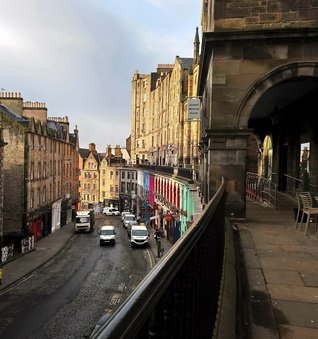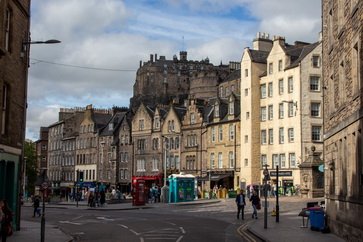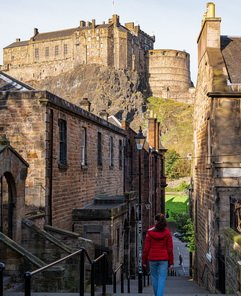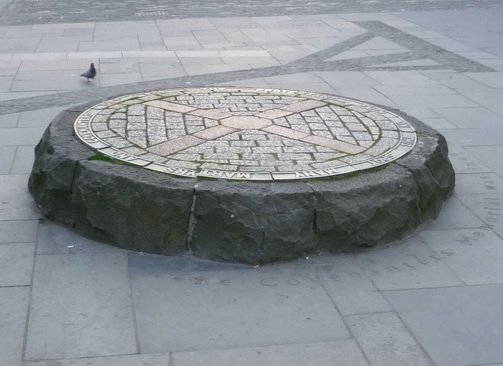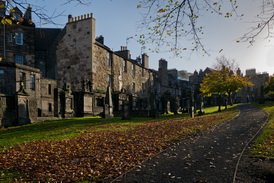Edinburgh grassmarket Walk
W
here to start
Grassmarket walk takes its name from the central point that we will be circling around. It is situated close to the Royal Mile and main places of interest. There are many hotels in the vicinity, so it is strongly possible that you know it already.
This walk will tell you more about the places that you pass every day. You can enjoy it on its own or add it to the Royal Mile walk. The tour lasts about an hour and I can safely say that you make a full circle.
For the purpose of logic and the other walk we will start at the crossroad of the Royal Mile and George IV Bridge. It is a very short distance to the first point of interest which will be the Victoria street.
1 Victoria Street
Standing on the lights with your back to the Castle you have Royal Mile straight in front of you. To the left there is the Mound Street that leads to Princes Street Gardens. To the right it is George IV Bridge.
Turn right, walk a few steps and take the first street to the right. It will lead down.
This is a beautiful example of an old merchant street, with lovely colorful building that looks great on the photo. It was created in XIX century in a process to improve and modernize the city. Improvement Act from 1867 destroyed some buildings, constructed a library and put a better access road from the West quarters. Among many Brodie’s family house was destroyed (Deacon Brodie story) and the West Bow Wizard’s tenement disappeared as well.
You see, Harry Potter was not the only wizard in Edinburgh. Major Weir was a soldier and a guard for the city before he retired. Then, around his 70th birthday, he confessed to be a warlock. He also admitted of having intimate relation with his sister and conversing with the devil. His sister only added to that and they were both executed. He – burned alive in 1670, outside the gates of the city, on the road to Leith (Leith Walk of today). Here the story could have ended, but the next inhabitants of the tenement talked about weird noises. People also claimed of hearing tapping on the streets. They said they had seen the necromancer with his staff, in a dark, long robe walking around the West Bow as he had used to. So beware…
In the middle of Victoria Street, on the right-hand side there are stairs leading up. If you take them, you will arrive at Victoria Terrace. This is also a direct shortcut to the Hub. At the top of the stairs, near the balustrade there is an information showing a picture of the original West Bow Street. You can also go up there for the photo. When the tenements further down are lighted by the sun they look magnificent and the colors are radiant.
Last but not least – according to J.K. Rowling – Victoria Street is the spark that created the Diagonal Alley, but more of this you can find in the Harry Potter article (click)
2 Grassmarket
Having descended down Victoria Street you will find yourself in a huge open space. This is the Eastern corner of a square. In front of you, in the middle of the street, there is a stone square with two heads. This is a well of old that distributed water to the occupants. Behind it, a bit to the right you should see a low wall that surrounds a stone circle. Go to see what it is (point 3). Or walk around Grassmarket following the text.
Nature formed this valley, as the other one on the northern side. There was a lake, here – a road going parallel to the Royal Mile. It led to a gate and then to the farms and pastures. It was the easiest way to get to the market that was here. Selling hay and animals. Those activities gave the name to this area and the road – Cowgate. The square received another one – Grassmarket and soon – the royal charter stating it privileges as a market (about XV century).
The city grew, the residences were built, the tenements started to descend the hill this way, a monastery of Greyfriars was installed nearby. All was well and not much changed since then neither with the function nor – the looks.
Going from the right to the far, western corner – you have plenty of good restaurants and pubs there. All popular, some telling you the stories of this place – like Maggie’s or Last Drop. Further away – White Hart Inn reminds about a long-distance coach station that was here.
At the western end you have King’s Stables Road leading to the Princes Street. Another one is West Port Road. This one tells you where a gate of the city once stood. You can even see a shadow on the pavement close by – telling you the name of the wall circling the city in XVI century – Flodden Wall (the stairs nearby give you a great photo-opportunity).
Not far from then – on the other side of Grassmarket already – there is Mary’s Milk Bar. A funny drawing on the pavement shows you how a queue should go… Do not laugh – they sell pretty good ice creams and there is some traffic in summer.
On this side of the square you will have some shops and hotels mostly. And in the center of Grassmarket you can find a farmers’ market on weekends. But check the Internet first for exact times.
If you went around, go back to the stone circle in the East end of the square.
3 Covenanters’ Memorial and Maggie Dickson
Having approached the stone circle you notice the names inscribed on it and the different color of the pavement.
The names written around you commemorate a group of people long dead. They were called the Covenanters and they took a very long walk from St. Giles, through the countryside to the prison in Greyfriars and from there – to the gallows.
Their story started with the return of Catholic religion to Scotland. It was King Charles I who decided it. Many opposed him and soon islands were covered in a War of Three Kingdoms. In Scotland Protestants signed an act called National Covenant – this is where they name came from. Not all battles were won. Some of them were captured, put in a prison and executed. The gallows stood in here – the different color of the pavement is a shadow of it. The sources say that 1200 were hanged here after first being tortured in Greyfriars prisons.
Not only the Covenanters died in here. Edinburgh had many execution spots. You need to think about it like a sort of a theatre for the masses. A kind where bad people were permanently punished. But not all stories terminated like that.

One of the victims hanged here was Maggie Dickson. She was a saleswoman, working and living in the Fishmarket Close in Edinburgh. She was poor, got pregnant and didn’t want the child. The baby was stillborn and Maggie left it with the river Leith. This way, she made a few mistakes. Hiding the pregnancy was the worst of it – a lawful crime punished by death. She was accused of killing her child and hanged here.
Her body was then taken to Musselburgh where her family lived. On the way, the driver stopped in a bar. He ate, drank, and returned to the cart only to hear a strange sound coming from the coffin. He opened it and found Maggie with a red line on her neck and open eyes.
Not knowing what to do, he turned around and brought the body back to the authorities of Edinburgh. They didn’t know more about what to do with her than the coachman. They wanted to hang her again, but then a law student came. He reminded that no one could be punished for a crime twice. And Maggie already died for killing her baby, the doctor checked and signed! So being a city, soon to be known by those lawyers – they let her live. And since she died already… she was relieved from paying taxes… for the rest of her life (too much paperwork)!
A bad story with a happy ending. She remarried and had children. She had a pub in here. People say that during executions she was standing in the window, smiling at the victim, both hoping that maybe there will be an after-life.
Explore the Grassmarket or go further. From the Covenanter’s memorial you need to cross the street on the closest traffic lights. Turn left and after a few meters you will arrive at a roundabout. The road going straight is called Cowgate and goes down to the Palace. You need to take the road up – it is called Candlemaker Row. Follow the wall up and the road up.
4 Greyfriars Kirkyard
Candlemaker Row ends at a junction with George IV Bridge. You should see it on your left. On your right there are Bobby’s restaurant and a black gate leading to a cemetery. Go inside – this is the next stop. You should see a church in front of you wit a road leading left, to the SW corner. the other road leads right – also to the SW corner but to the northern parts of the place as well.
The National Covenant was signed in the very church that you can see in 1637. The Covenanter Prisoners hung in Grassmarket were held in the SW corner of the cemetery. That part is closed, but you can have a peak through the gate there. The easiest way to have a look at it is to take the left path passing the church on your right.
On your way there you will see a mausoleum with a dome on your left. This is the grave of George MacKenzie who interrogated them. For those deeds he received another name – Bloody George or Bloody MacKenzie. The legend says that the grounds of the kirkyard are still haunted by both the prisoners and their oppressor…
This place wasn’t always a cemetery. At the beginnings of the city the main church was St Giles. The burial ground was there. Here, as the name says, was the place of Greyfriars – they had their abbey around you. But the Reformation came, and the monks fled. The land was not used and belonged to the state. Mary Queen of Scots gave it to the city that needed another place to bury their dead.
It was turned into a cemetery and the church was built here around 1620. It is in use since then and in this relatively small area thousands are buried! Because of the lack of space, they were put in the ground one on another. Creepy, but true – you are walking on the graves of others. But don’t worry!!! In Italy they say that the living has to do that in order to shorten the Purgatory period of the dead! Uff….
5 Flodden Wall and the second part of the cemetery
Go around the church. If you came to see Covenanters Prison you should be there by now. Behind the church, not seen from the main entrance, there is a wall with a passage. When you go through it you see another part of the cemetery. You can also spot a closed gate – it leads to the grounds of George Heriott School – the castle-like structure that can be easily seen from here.
Another story of the place relates to the wall behind the church. It is the famous Flodden Wall that encircled the city from XVI century. There are only a few original parts still visible and this is one of them.
The wall got its name after a battle lost by king James IV. The flower of Scottish knights was killed there. The city fearing the Englishmen built this wall for protection. But they didn’t have enough soldiers to man it. When in XVI century the armies of king Henry VIII came for their Killing Time, they entered the city with no difficulties and almost burned it entirely.
A hidden treasure of this corner of the Kirkyard is a part of the Harry Potter story. J.K. Rowling used to walk around Edinburgh putting her daughter to sleep. Apparently in this very spot she found an inspiration for Lord Voldemort.
To see a grave of Thomas Riddle you need to turn right after you pass the Flodden Wall. Go to the bottom, turn right and check the names on the Flodden W all. The one, you want should be well visible – even by the number of feet that made a path to it.
6 Mortsafes and graverobbers
Go back the same way, through the arch. Go to the main gate of the cemetery, preferably taking the right way. Somewhere in the middle, when you pass the church, there should be a metal cage on one of the graves.
It is called a mortsafe. In XVIII and XIX centuries Edinburgh was full of graverobbers or Resurrectionists – as they called themselves. Cadavers were mainly sold to the School of Medicine for obvious reason. The easiest way to acquire a body was to simply dig it out. The graverobbers were waiting for a ceremony to take place and soon after it came in the dark hours of the night. Wealthy people built mausoleums – like the one of George MacKenzie. Others used the mortsafes like this one. It was a part of the cemetery’s service. A metal cage was put on the grave, too heavy to be lifted without somebody noticing. It was left there until the body started to decompose and was useless for the graverobbers. And so, the client was protected. Those who had no money relied on the services of the cemetery’s guardians. They seldomly had a special house or a watchtower built for them. You can see one in the cemetery of St Cuthbert Church (Lothian Road).
The most famous in this business were Burke and Hare who created the bodies by killing people. They sold them to Dr Robert Knox. They were discovered because one of the students recognized a female he was studying. From there the investigation started. Burke was hanged in front of St. Giles, Hare and Knox exiled.
7 Greyfriars Bobby
Direct yourself to the main entrance. Try to stand close to the gate. You need to locate two points. One is still in the graveyard. Form the position close to the gate, when you look at the church, there should be a grave close to the walking path. Maybe there are some toys, sticks or flowers there. This is a tomb of Bobby.
The second thing can be seen through the gate, when you look to the George IV Bridge. Try to locate a small, black statue near the railing. Maybe people are taking photos with it. It is just on the corner of Candlemaker Row and George IV Bridge – the Statue of Bobby.
Edinburgh has a very famous cemetery watchman. Not too long ago, in the XIX century a man was employed here. His name was John Gray and he loved his job. He was walking around cemetery profiting from the peaceful atmosphere. It is said he was not like all the other watchmen; he was a good one, you couldn’t bribe him and dig a body out. But he was alone, and he needed help.
There is nothing better than a fearful dog that can signal a thief coming and protect when the need comes. John thought that too and he found himself a mighty friend to help him in the night. Maybe nobody explained this to him, like I did above, because John got himself a Skye Terrier. Yes… for those who know. For the rest – this particular dog grows up to 26 cm of height maximum and is just adorable!
Doesn’t matter – Bobby was a great friend and accompanied his John on the walks during the day and night. But life goes on, and people die, as did John in 1858. Here the story could end, but Bobby had another opinion. Visiting his master’s grave in Greyfriars is not strange. But making turns of the cemetery, alone this time is. And he did so for 14 years. He won the sellers around the cemetery who started to feed him. He won the cemetery caretakers who built him a kennel next to John’s grave. He even won over the city council because to protect him – a stray dog now – he received a collar from the Provost. At his own death he couldn’t be buried in a sacred ground next to John. But he was buried close enough – that is the grave you needed to spot. Maybe there are stick, toys or flowers there. People all over the world love him and tend to leave him something. (John’s grave is marked on the map of the cemetary – it should be somewhere close tot he church building).
As you approach the statue you will see the Skye Terrier. It is in 1:1 scale so you can truly see how vicious he was. The golden nose is rubbed for luck – but it is just a made up legend.
8 National Museum of Scotland
Standing close to Bobby Statue look on the other side of George IV Bridge. There is a huge, brown-yellow building at the corner. The street there is called Chalmers Street. You should be able to spot a small square opening there, flanked by a standing statue on a pedestal. The entrance to the museum is right over there.
National Museum of Scotland is a merge of two collections and two buildings. When you approach the entrance you see a darkened Victorian façade. But to the right there is a newly added modern part – also belonging to the museum.
It is huge! You have two wings and main part with 3 floors but there is also an addition going up 3 more floors (if you add the roof). You can find treasures of all the Scottish history there – starting with ancient, geological times of the dinosaurs and going to modern eras.
Among many there is a T-rex, Dolly the sheep, Scottish inventions, archeological artifacts, Scottish Maiden – the early form of a guillotine, Elton John’s suits, Mackintosh arts, cotton weavers’ corner, ships, locomotive, bridges and many, many more.
It is free to visit but it takes time to really enjoy it – three hours are the least you can spend there and you won’t even notice. It is one of those attractions with a roof above your head so you can visit it on a rainy day.
Whether from a museum of the Kirkyard you need to return to George IV Bridge. And walk in the direction of the Royal Mile – with the museum on the right and cemetery on the left. Try walking on the left side of the road. You need to look for a coffee shop with a red front.
9 Elephant House
This small restaurant with a red front sits on George IV Bridge between the Greyfriars and the Royal Mile. It is a site visited by Harry Potter fans and it is always full. Many come to see the collection of things connected to J.K.Rowling and maybe sit on the very spot where she once sat. The back of the restaurants offers a lovely view to the cemetery and the castle. It was probably what inspired the creation of Hogwarts.
The author had problems putting her child to sleep so she walked a lot. In rare times when the baby slept – she sat in a bar and wrote. This one is one of many and if you want to know more try the Harry Potter Walk. (coming soon)
The End
Going back to the Royal Mile makes you pass two imposing buildings on both sides of the road. The on on the left is the Public Library – on the right you have National Library. Both were built in times of the Improvement Act from 1827 the same one that created Victoria Street.
Getting to the traffic lights make you return to the Mile. You just made a full circle. You can continue on your own – if it is only the part for the Grassmarket Walk today. If you linked it to the Royal Mile Walk – you need to turn right at the lights.
At the corner on the opposite side of the road, in front of the sitting statue – try looking under your feet for 3 cobbles making H shape. You should start reading from point 7 of the Royal Mile Walk.


